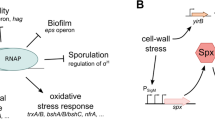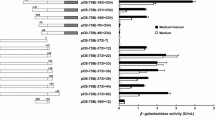Summary
In Bacillus subtilis the abrB gene product negatively affects the transcription of some genes activated during the transition from vegetative to stationary phase of growth. Interaction of AbrB with the promoters of two such genes, spoVG, a sporulation gene, and tycA, an antibiotic biosynthesis gene, was studied by DNase I and hydroxyl radical footprinting. Two binding areas within the leader and promoter regions of tycA were identified. In spoVG the binding site is located at the A+T-rich region upstream of the promoter. Hydroxyl radical footprinting revealed that the AbrB-protected regions, in both the tycA and spoVG promoters, are short A+T-rich regions that are separated by one helical turn, indicating that AbrB binds to one face of the helix. To examine the role of spoOA in the expression of abrB-controlled genes, the levels of AbrB protein in Spo+ and in spoOA cells were determined by Western blot analysis. In wild-type cells AbrB was detected only during vegetative growth, whereas in spoOA cells a high level of AbrB was detected during both the vegetative and stationary phases of growth. These findings support a model in which (i) spoOA negatively affects abrB expression, and (ii) the repression of the transition state-activated genes tycA and spoVG in spoOA cells is due to constitutive expression of AbrB, which acts as a repressor.
Similar content being viewed by others
References
Bossi L, Smith DM (1984) Conformational change in the DNA associated with an unusual promoter mutation in a tRNA operon of Salmonella. Cell 39:643–652
Bradford MM (1976) A rapid, sensitive method for the quantitation of microgram quantities of protein utilizing the principle of protein-dye binding. Anal Biochem 72:248–254
Burkhoff AM, Tullius TD (1987) The unusual conformation adopted by adenine tracts in kinetoblast DNA. Cell 48:935–943
Ferrari FA, Trach K, Le Coq P, Spencer J, Ferrari E, Hoch JA (1985) Characterization of the spoOA locus and its deduced product. Proc Natl Acad Sci USA 82:2647–2651
Ferrari E, Henner DJ, Perego M, Hoch JA (1988) Transcription of Bacillus subtilis subtilisin and expression of subtilisin in sporulation mutants. J Bacteriol 170:289–295
Gralla JD (1989) Bacterial gene regulation from distinct DNA sites. Cell 57:193–195
Hanson RS, Blicharska J, Szulmajster J (1964) Relationship between the tricarboxylic cycle enzymes and sporulation. Biochem Biophys Res Commun 17:1–5
Hennighausen L, Lubon H (1987) Interaction of protein with DNA in vitro. Methods Enzymol 152:721–735
Johnson AD, Meyer BJ, Ptashne M (1979) Interactions between DNA-bound repressors govern regulation by the lambda phage repressor. Proc Natl Acad Sci USA 76:5061–5065
Laemmli UK (1970) Cleavage of structural proteins during assembly of the head of the bacteriophage T4. Nature 227:680–685
Losick R, Youngman P, Piggot PJ (1986) Genetics of endospore formation in Bacillus subtilis. Annu Rev Genet 20:625–669
Maniatis T, Fritsch EF, Sambrook J (1982) Molecular cloning: A laboratory manual. Cold Spring Habour Laboratory, Cold Spring Habour, NY
Marahiel MA, Zuber P, Czekay G, Losick R (1987) Identification of the promoter for a peptide antibiotic biosynthesis gene from Bacillus brevis and its regulation in Bacillus subtilis. J Bacteriol 169:2215–2222
Marini JC, Levene SD, Crothers DM, Englund PT (1982) Bent helical structure in kinetoplast DNA. Proc Natl Acad Sci USA 79:7664–7668
Marini JC, Effron PN, Goodman TC, Singleton CK, Wells RD, Wartell RM, Englund PT (1984) Physical characterization of a kinetoplast DNA fragment with unusual properties. J Biol Chem 259:8974–8979
Maxam AB, Gilbert W (1980) Sequencing end-labeled DNA with base-specific chemical cleavages. Methods Enzymol 65:499–560
Mizuno T (1987) Static bend of DNA helix at the activator recognition site of the ompF promoter in E. coli. Gene 54:57–64
Nelson HC, Finch JT, Bonaventura FL, Klug A (1987) The structure of an oligo (dA) oligo (dT) tract and its biological implications. Nature 330:221–226
Nixon BT, Ronson CW, Ausubel FM (1986) Two component regulatory systems responsive to environmental stimuli share strongly conserved domains with the nitrogen assimilation regulatory genes ntrB and ntrC. Proc Natl Acad Sci USA 83:7850–7854
Perego M, Spiegelman GB, Hoch JA (1988) Structure of the gene for the transition state regulator, abrB: regulator synthesis is controlled by the spoOA sporulation gene in Bacillus subtilis. Mot Microbiol 2:689–699
Perego M, Cole SP, Burbulys SD, Trach K, Hoch JA (1989) Characterization of the gene for a protein kinase which phosphorylates the sporulation-regulatory proteins SpoOA and SpoOF of Bacillus subtilis. J Bacteriol 171:6187–6196
Robertson JB, Gocht M, Marahiel MA, Zuber P (1989) AbrB, a regulator of gene expression in Bacillus, interacts with the transcription initiation regions of a sporulation gene and an antibiotic biosynthesis gene. Proc Natl Acad Sci USA 86:8457–8461
Ryder K, Silver S, De Lucia AL, Fanning E, Tegtmeyer P (1986) An altered DNA conformation in origin region I is a determinant for the binding of SV 40 large T antigen. Cell 44:719–725
Snyder M, Buchman AR, Davis R (1986) Bent DNA at a yeast autonomously replicating sequence. Nature 324:87–89
Stenzel TT, Patel P, Bastia D (1987) The integration host factor of Escherichia coli binds to bent DNA at the origin of replication of the plasmid pSC 101. Cell 49:709–717
Strauch MA, Perego M, Burbulys D, Hoch JA (1989a) The transition state transcription regulator AbrB of Bacillus subtilis is autoregulated during vegetative growth. Mol Microbiol 3:1203–1209
Strauch MA, Spiegelman GB, Perego M, Johnson WC, Burbulys D, Hoch JA (1989b) The transition state regulator abrB of Bacillus subtilis is a DNA binding protein. EMBO J 8:1615–1621
Strauch MA, Webb V, Spiegelman G, Hoch JA (1990) The SpoOA protein of Bacillus subtilis is a repressor of the abrB gene. Proc Natl Acad Sci USA 87:1801–1805
Trach K, Chapman JW, Piggot PJ, Hoch JA (1985) Deduced product of the stage O sporulation gene spoOF shares homology with the SpoOA, OmpR, and SfrA proteins. Proc Natl Acad Sci USA 82:7260–7264
Tullius TD, Dombroski BA (1986) Hydroxyl radical “footprinting”: high resolution information about DNA protein contacts and application to lambda repressor and Cro protein. Proc Natl Acad Sci USA 83:5469–5473
Wu H-M, Crothers DM (1984) The locus of sequence-directed and protein-induced DNA bending. Nature 308:509–513
Yang C-C, Nash HA (1989) The interaction of E. coli IHF protein with its specific binding sites. Cell 57:869–880
Zahn K, Blattner FR (1987) Direct evidence for DNA bending at the lambda replication origin. Science 236:416–422
Zuber P, Losick R (1987) Role of AbrB in SpoOA- and SpoOB-dependent utilization of a sporulation promoter in Bacillus subtilis. J Bacteriol 169:2223–2230
Zuber P, Healy JB, Losick R (1987) Effects of plasmid propagation of a sporulation promoter on promoter utilization and sporulation in Bacillus subtilis. J Bacteriol 169:461–469
Zuber P, Marahiel MA, Robertson J (1988) Influence of AbrB on the transcription of the sporulation-associated genes spoVG and spoOH in Bacillus subtilis. In: Hoch JA, Ganesan AT (eds) Genetics and biotechnology of bacilli. Academic Press, New York, pp 123–127
Author information
Authors and Affiliations
Additional information
Communicated by W. Goebel
Rights and permissions
About this article
Cite this article
Fürbaß, R., Gocht, M., Zuber, P. et al. Interaction of AbrB, a transcriptional regulator from Bacillus subtilis with the promoters of the transition state-activated genes tycA and spoVG . Molec. Gen. Genet. 225, 347–354 (1991). https://doi.org/10.1007/BF00261673
Received:
Issue Date:
DOI: https://doi.org/10.1007/BF00261673




